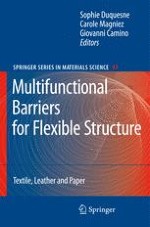2007 | Buch
Multifunctional Barriers for Flexible Structure
Textile, Leather and Paper
herausgegeben von: Dr. Sophie Duquesne, Dr. Carole Magniez, Dr. Giovanni Camino
Verlag: Springer Berlin Heidelberg
Buchreihe : Springer Series in Materials Science
